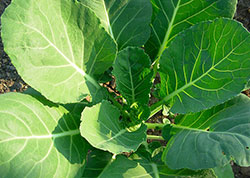Collards can grow to a height of three feet and are well known as a Southerner’s eating delight. They grow best in cool weather and fertile soil, and require  abundant moisture. You can transplant collards into your early-spring garden to produce a midsummer crop, or you can plant them in midsummer and harvest them from fall to early winter, as they are quite tolerant of early fall frosts.
abundant moisture. You can transplant collards into your early-spring garden to produce a midsummer crop, or you can plant them in midsummer and harvest them from fall to early winter, as they are quite tolerant of early fall frosts.
Collard leaves, which can be plucked several times from the main stem, offer fresh greens that are low in calories and high in vitamins C and A. Though heat- tolerant, summer-harvested collards often have tough leaf midribs that are best removed. In the fall, midribs are tender and sweet. Popular wisdom has it that collards are sweeter after the first frost, but cool temperatures achieve the same result. This is because cool weather changes starches, which are stored in the leaves into sugars. It also changes the structure of some proteins, which enhance flavor. Minimal cooking preserves the best color and vitamin content of this easy-to-grow vegetable.
Collards are closely related to kale and fall into two categories — loose-leaf and cabbage varieties. Popular loose-leaf varieties include Vates, Dwarf Blue Scotch and Curled collards. Green Glaze is an old, shiny-leaf variety that’s noteworthy because it’s less attractive to the cabbage moth caterpillar.
Cabbage collards spread wide from their bases, but stay more compact. Morris Heading and Cabbage Collards are the best-known varieties.



